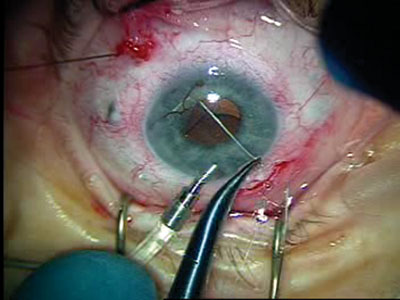New method of transscleral fixation an alternative for securing IOLs
The technique offers surgeons another option when securing the lens in an eye that is damaged or aphakic.
 Thomas John |
Optimal placement of an IOL is within an intact posterior lens capsule with good zonular support. However, ophthalmic surgeons are faced with situations during cataract surgery in which an occasional inadvertent, extensive lens capsular tear may remove the option of placing the lens in the capsular bag, requiring a different location to make the eye pseudophakic. Alternatively, a patient who has been aphakic with an aphakic contact lens may elect to have a secondary IOL placement due to a recent inability to wear the contact lens, or there may be situations in which an IOL exchange may be required when dealing with a subluxated IOL. In these situations and others, the choices for a secondary IOL placement include the anterior chamber, iris-fixation and scleral-fixation using transscleral sutures. Based on a literature review, Wagoner and colleagues suggested that all three IOL location options are safe and effective choices in the absence of lens capsular support for IOL implantation. When the surgeon elects to place an IOL in the ciliary sulcus, away from the corneal endothelium, the options include fixating the IOL to the sclera using sutures or tucking the haptics within scleral pockets without the use of sutures.
In this column, Dr. Siepser describes a useful surgical technique of using a suture loop (mattress approach) to anchor a Crystalens (Bausch + Lomb) to the sclera through a small-incision approach. Long-term follow-up of these patients with this surgical approach will provide IOL stability and safety data.
Thomas John, MD
OSN Surgical Maneuvers Editor
 Steven B. Siepser |
Skilled surgeons often have the innate qualities of excellent hand-eye coordination, dexterity, courage, a high risk tolerance and the all important selective memory. These characteristics allow the more intrepid to move forward with new techniques and maneuvers. Here is one for my colleagues’ quiver of backup plans when something goes thump in the night or in the OR.
There are now more than 30 different methods for transsclerally fixating a posterior chamber IOL. These wonderful opportunities and variations of method are important to improve and increase the cataract surgeon’s surgical armamentarium. Using transsclerally fixated IOLs has waxed and waned over time as needs change. Our initial techniques involved the use of PMMA implants and rather large wounds. The technique for transsclerally fixated IOLs was developed not only to use with the modern foldable implants but also helped to bring about the highest technology implants for eyes that were damaged in some way or were aphakic. As it turns out, the construction and design of the Crystalens have an additional indication and use. The polyamide haptics create a natural structure for stabilization of a mattress suture and placement of the lens in the sulcus. This is an effective, efficient and quick small-incision technique for placement of transsclerally fixated posterior chamber IOLs.
 An SSL-15 needle is passed lateral to the silicone portion of the haptic. The needle is directed into the ciliary sulcus. A chamber maintainer is used to provide maximum visibility and a more physiologic iris position. Images: Siepser SB |
 The other end of the SSL-15 mattress suture is passed lateral to the haptic to capture the polyimide prongs. The needle is nursed along the iris to enter the most anterior portion of the ciliary sulcus. |
 The superior haptic is then pushed into the posterior segment with a Lester hook. The mattress sutures are placed under tension to deliver the haptic into the ciliary sulcus. |
The IOL is introduced into the anterior chamber under Healon (sodium hyaluronate, Abbott Medical Optics) or a viscodispersive agent. An SSL 20 needle is then used in a mattress fashion on either side of the haptics, placed at the optic rim and pupillary aperture into the ciliary sulcus in a horizontal fashion. The same is done in the other direction. The sutures are taut. The IOL is popped into the posterior chamber and suspended from the sulcus, resulting in a transsclerally fixated lens.
This quick and efficient method has helped several patients of ours who have difficulty either with a transsclerally fixated lens or a large-incision PMMA sulcus-stabilized lens. The advent of this technique gives surgeons another option and patients the possibility of better visual performance.
See video of technique at OSNSuperSite.com/view.aspx?rid=78643.
References:
- Bading G, Hillenkamp J, Sachs HG, Gabel VP, Framme C. Long-term safety and functional outcome of combined pars plana vitrectomy and scleral-fixated sutured posterior chamber lens implantation. Am J Ophthalmol. 2007;144(3):371-377.
- Wagoner MD, Cox TA, Ariyasu RG, Jacobs DS, Karp CL; American Academy of Ophthalmology. Intraocular lens implantation in the absence of capsular support: a report by the American Academy of Ophthalmology. Ophthalmology. 2003;110(4):840-859.
- Zandian M, Moghimi S, Fallah M, Crandall A. Ab externo iris fixation of posterior chamber intraocular lens through small incision. J Cataract Refract Surg. 2010;36(12):2032-2034.
- Thomas John, MD, is a clinical associate professor at Loyola University at Chicago and is in private practice in Oak Brook, Tinley Park and Oak Lawn, Ill. He can be reached at 708-429-2223; fax: 708-429-2226; email: tjcornea@gmail.com.
- Steven B. Siepser, MD, FACS, can be reached at Siepser Laser Eyecare, 860 E. Swedesford Road, Wayne, PA 19087; 610-265-2020; fax: 610-265-4054; email: ssiepser@clear-sight.com.
- Disclosures: Drs. John and Siepser have no direct financial interest in the products discussed in this article, nor are they paid consultants for any companies mentioned.

